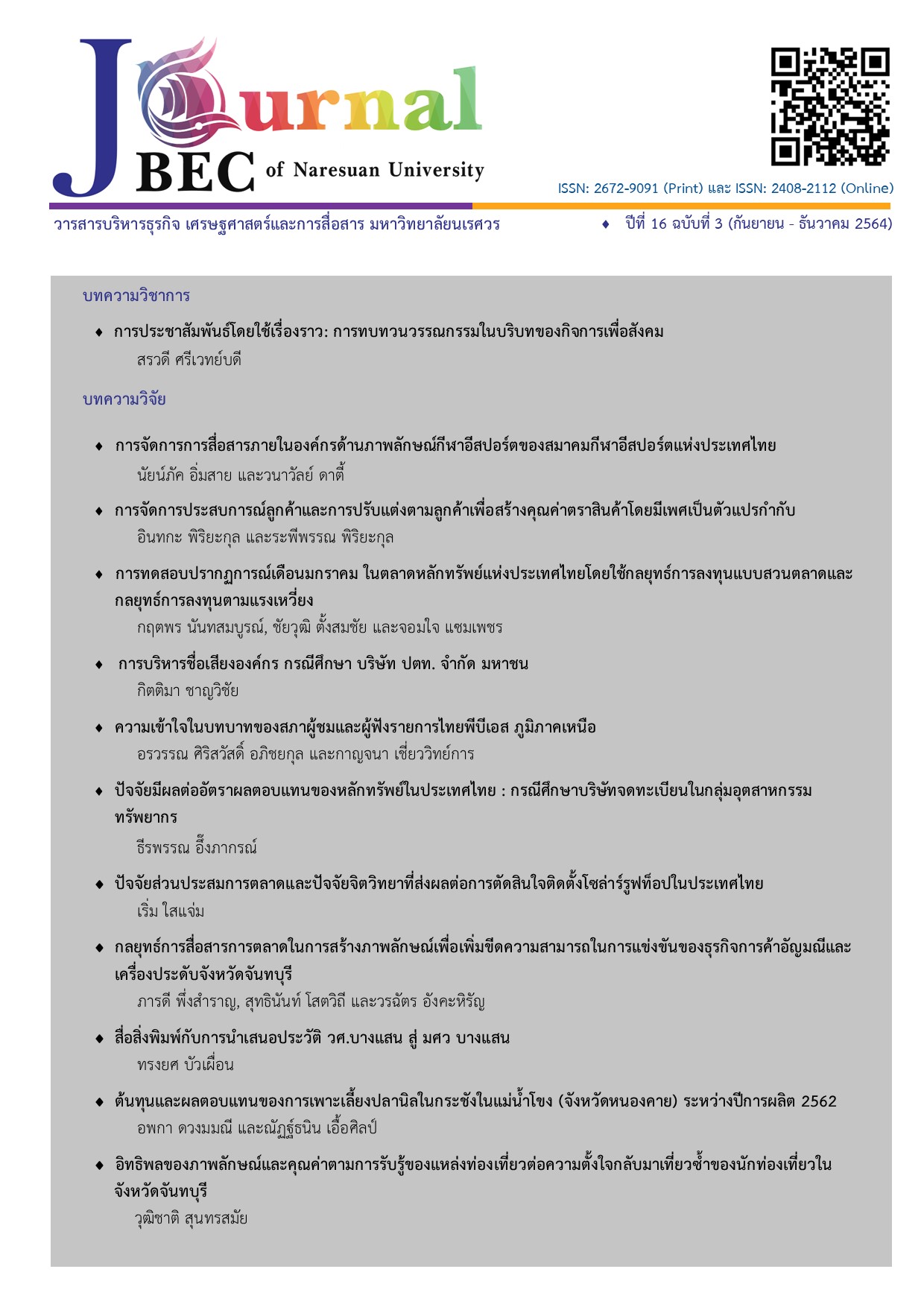การประชาสัมพันธ์โดยใช้เรื่องราว: การทบทวนวรรณกรรมในบริบทของกิจการเพื่อสังคม
Main Article Content
บทคัดย่อ
การประชาสัมพันธ์ นับเป็นเครื่องมือสื่อสารการตลาดที่ใช้เสริมสร้างความสัมพันธ์และความเข้าใจอันดีระหว่างองค์การ สถาบันและกลุ่มประชาชน (Lapirattanakul, 2010, p. 9) ในช่วงที่ผ่านมา จะเห็นได้ว่ากิจการต่างๆ รวมถึงกิจการเพื่อสังคม นิยมใช้การประชาสัมพันธ์โดยใช้เรื่องราวในการสื่อสารคุณค่าทางอารมณ์ระหว่างกิจการและผู้มีส่วนได้ส่วนเสีย ตลอดจนสร้างความโปร่งใสในกระบวนการดำเนินกิจการที่เน้นวัตถุประสงค์ทางสังคมเป็นหลัก จากความสำคัญของหัวข้อดังกล่าว การศึกษานี้ มีวัตถุประสงค์เพื่อ ก) เพื่อศึกษาลักษณะสำคัญ บทบาทและแนวทางของการประชาสัมพันธ์โดยใช้เรื่องราวในบริบทของกิจการเพื่อสังคม และ ข) เพื่อศึกษาช่องทางการประชาสัมพันธ์ในการถ่ายทอดเรื่องราวของกิจการเพื่อสังคม ทั้งนี้ เพื่อตอบโจทย์วัตถุประสงค์ดังกล่าว การศึกษานี้ใช้รูปแบบการวิจัยเชิงเอกสารอย่างเป็นระบบตามแนวทางของ PRISMA Reporting Guidelines โดยทบทวนวรรณกรรมงานวิจัยที่เกี่ยวข้อง โดยเฉพาะอย่างยิ่งงานวิจัยเชิงประจักษ์ ผลการศึกษาชี้ว่าผู้ประกอบกิจการเพื่อสังคม ใช้การเล่าเรื่องราวความรุนแรงของปัญหาและสิ่งที่กิจการแก้ไข เป็นอันดับหนึ่ง รองลงมาคือ เรื่องราวผู้ก่อตั้งและผู้ได้รับประโยชน์ ตามลำดับ ในแง่ของช่องทางประชาสัมพันธ์เรื่องราว พบว่าผู้ประกอบการเพื่อสังคม ใช้ช่องทางประชาสัมพันธ์เรื่องราวโดยผ่านกิจกรรมพิเศษเป็นอันดับหนึ่ง รองลงมาคือเว็บไซต์และสื่อสังคมออนไลน์ และการปราศรัยตามเวทีและการให้สัมภาษณ์ต่อสื่อมวลชน การศึกษานี้ จะช่วยต่อยอดองค์ความรู้และงานวิจัยเชิงวิชาการในหัวข้อการประชาสัมพันธ์โดยใช้เรื่องราวในบริบทของกิจการเพื่อสังคม และมีประโยชน์ต่อผู้ประกอบการกิจการเพื่อสังคมในการวางแผน จัดการและพัฒนาประชาสัมพันธ์โดยใช้เรื่องราวให้มีประสิทธิภาพยิ่งขึ้น
Article Details

อนุญาตภายใต้เงื่อนไข Creative Commons Attribution-NonCommercial-NoDerivatives 4.0 International License.
เอกสารอ้างอิง
Bandyopadhyay, C. and Ray, S. (2019). Social enterprise marketing: Review of literature and future research agenda. Marketing Intelligence and Planning, 38(1), 121-135.
Booth, P., Chaperon, S., Kennell, J. S. and Morrison, A. M. (2020). Entrepreneurship in island contexts: A systematic review of the tourism and hospitality literature. International Journal of Hospitality Management, 85, 102348.
Brooks, A. C. (2009). Social entrepreneurship: A modern approach to social value creation. Upper Saddle River, NJ: Prentice Hall.
Craig, P. D., Ray, R., Harvey, D., and Shircore, M. (2020). Factors which influence hospital doctors’ advance care plan adherence. Journal of Pain and
Symptom Management, 59(5), 1109-1126.
D’ Eusanio, M., Zamagani, M. and Petti, L. (2019). Social sustainability and supply chain management: methods and tools. Journal of Cleaner Production, 235(20), 178-189.
Doherty, B., Foster, G., Mason, C., Meehan, J., Meehan, K., Rotheroe, N. and Royce, M. (2009). Marketing for social enterprises. In Management for Social Enterprises. (pp. 135-171), London: Sage.
Doherty, B. (2011). Resource advantage theory and fair trade social enterprises. Journal of Strategic Marketing, 19(4), 357-380.
Fenger, M. H. J., Aschemann-Witzel, J., Hansen, F. and Grunert, K. G. (2015). Delicious words –assessing the impact of short storytelling messages on consumer preferences for variations of a new processed meat product. Food Quality and Preference, 41, 237-244.
Fisac-Garcia, R., Acevedo-Ruiz, M., Romero, A. M. and Kreine, T. (2013). The role of ICT in scaling up the impact of social enterprises. Journal of Management for Global Sustainability, 2, 83-105.
Froggett, L. and Chamberlayne, P. (2004). Narratives of social enterprise from biography to practice and policy critique. Qualitative Social Work, 3(1).
Gilliam, D. A. and Zablah, A. R. (2013). Storytelling during retail sales encounters. Journal of Retailing and Consumer Services, 20, 488-494.
Herskovitz, S. and Crystal, M. (2010). The essential brand persona: Storytelling and branding. Journal of Business Strategy, (3), 21-28.
Hibbert, S. A., Hogg, G. and Quinn, T. (2005). Social entrepreneurship: Understanding consumer motives for buying the Big Issue. Journal of Consumer Behaviour: An International Research Review, 4(3), 159-172.
Kickul, J. and Lyons, T. S. (2012). Understanding social entrepreneurship: the relentless pursuit of mission in an ever changing world. New York: Routledge.
Kline, C., Shah, N. and Rubright, H. (2014). Applying the positive theory of social entrepreneurship to understand food entrepreneurs and their operations. Tourism, Planning and Development, 11(3), 330–342.
Lapirattanakul, V. (2010). Public Relations. (10th Edition). Bangkok: Chulalongkorn University.
Madill, J. and Ziegler, R. (2012). Marketing social missions – adopting social marketing for social entrepreneurship? a conceptual analysis and case study. International Journal of Nonprofit and Voluntary Sector Marketing, 17, 341-351.
Mair, J. and Marti, I. (2006). Social entrepreneurship research: a source of explanation, prediction and delight. Journal of World Business, 41(1), 36–44.
Margiono, A., Kariza, A. and Heriyati, P. (2019). Venture legitimacy and storytelling in social enterprises. Small Enterprise Research, 26(1), 55-77.
Matei, L. and Sandu, C. (2013). Social enterprise: Towards a marketing approach. Responsibility and Sustainability, 1(3), 51-57.
Moher, D. (2009). Preferred reporting items for systematic reviews and meta-analyses: The PRISMA statement. Plos Medicine, 6(7), 1-6.
Mora, P. and Livat, F. (2013). Does storytelling add value to fine Bordeaux wines?. Wine Economics and Policy, 2, 3-10.
Nuchpiam, P., Prateeppornnarong, D. and Janecharatsakul, B. (2019). Social enterprises in Thailand:Some observations towards Social Enterprise Promotion Bill. Journal of Thai Ombudsman, 11(1), 110-141.
Panyakul, V. R. (2013). Climate change adaptation through agro-social enterprise: Green Net’s experiences in Thailand. Asian Journal of Environment
and Disaster Management, 4(4), 1-16.
Rasmussen, W. (2012). Selling good: the big picture of marketing for social enterprises. In Volkmann, C. K., Tokarshi, K. O. and Ernst, K. (Eds.), Social entrepreneurship and social business: an introduction and discussion with case studies (pp. 133-156). Wiesdaden:Springer Gabler.
Roundy, P. T. (2015). Doing good by telling stories: emotion in social entrepreneurship communication. Journal of Small Business Strategy, 24(2), 41-68.
Ryder, P. and Vogeley, J. (2018). Telling the impact investment story through digital media: An Indonesian case study. Communication Research and Practice, 4(4), 375-395.
Sharma, S. and Oremus, M. (2018). PRISMA and AMSTAR show systematic reviews on health literacy and cancer screening are of good quality. Journal of Clinical Epidemiology, 99, 123-131.
Shaw, E. (2004). Marketing in the social enterprise context: Is it entrepreneurial?” Qualitative Market Research: an International Journal, 7(3), 194-205.
Siripattarasopon, S. (2015). A conceptual study of social enterprise development in Thailand. Journal of the Association of Researchers, 20(2), 30-47.
Srivetbodee, S., Igel, B. and Kraisornsuthasinee, S. (2017). Creating social value through social enterprise marketing: case studies from Thailand’s food-focused social entrepreneurs. Journal of Social Entrepreneurship, 8 (2), 201-224.
Virtue Ventures LLC. (2010). The four lenses strategic framework: towards an integrated social enterprise methodology. Retrieved April 10, 2020, from http://www.4lense.org
Wong, A. H. K. and Tse, F. W. L. (2016). Social media, networking, and marketing performance: a study of social enterprises in Hong Kong (HKIBS Working Paper Series 076-1516). Retrieved May 2, 2020, from http://commons.ln.edu.hk/hkibswp/77
Zak, P. J. (2014). Why your brain loves good storytelling. Harvard Business Review. Retrieved May 2, 2020, from https://hbr.org/2014/10/why-your-brain-loves-good-storytelling
Zamantılı Nayır, D. and Shinnar, R.S. (2020). How founders establish legitimacy: A narrative perspective on social entrepreneurs in a developing country context. Social Enterprise Journal, DOI. https://doi.org/10.1108/SEJ-10-2019-0073


